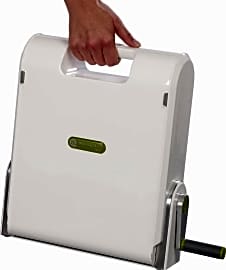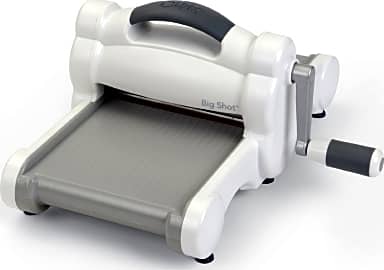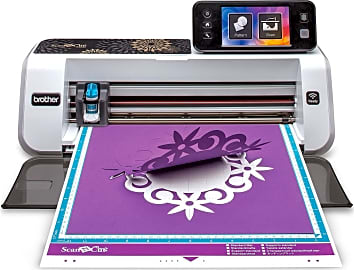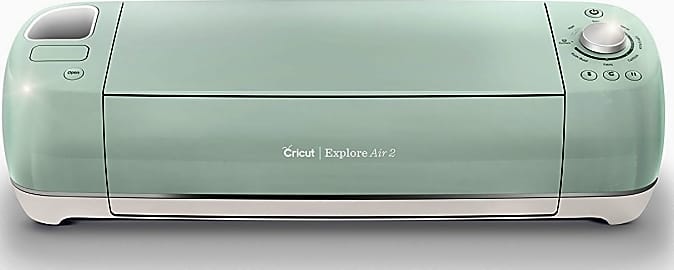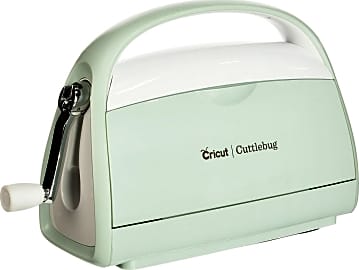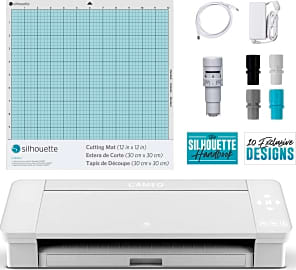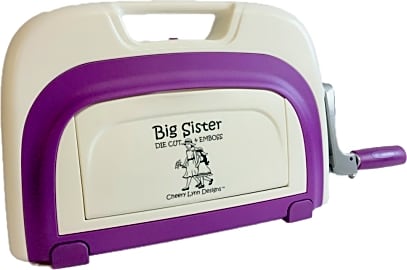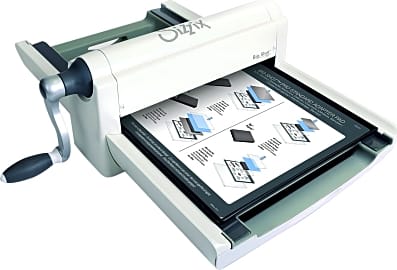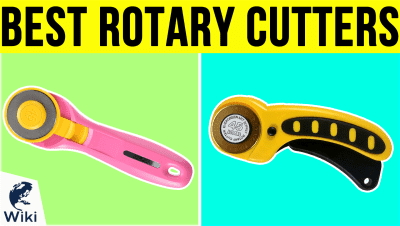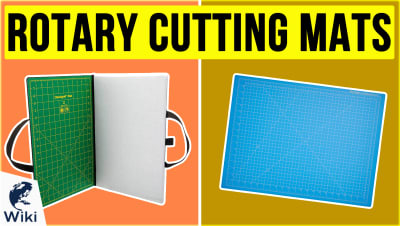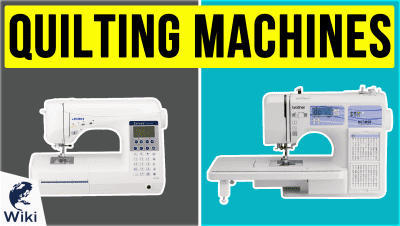The 10 Best Cutting Machines

This wiki has been updated 38 times since it was first published in May of 2015. For all you crafty people out there, you can die, cut, and emboss to your heart's content with one of these machines. Much more than a simple guillotine, these models offer creativity and, in some cases, computer connectivity, and are capable of delivering beautiful patterns for embroidery, paper crafting, home decor, and more. Some are suitable for small businesses, too. When users buy our independently chosen editorial picks, we may earn commissions to help fund the Wiki.
Editor's Notes
July 25, 2020:
We've updated our choices to include new models of a few favorites, including the Silhouette Cameo 4, which replaces the Cameo 3, and the latest version of the Brother ScanNCut 2. As with most other high-tech choices, including the Cricut Explore Air 2 and the Cricut Maker, these models work best when the user has some familiarity with design software and connectivity options. But if you are willing to follow set-up directions and learn how to operate the machine efficiently, you'll be able to create all kinds of projects, from invitations to scrapbooks.
For those who prefer a simple, hand-crank choice, both the Sizzix Big Shot and the Sizzix Big Shot Pro are still ones to consider. The latter is larger, heavier, and more robust, and as you might expect, more expensive, as well. Or, for light duty, there's the Cricut Cuttlebug and the Cheery Lynn Big Sister. They don't give you all the custom design options of electronic choices, but they are uncomplicated and get the job done.
Finally, for quilters, we selected the AccuQuilt Go. It can replace your rotary cutter and cutting mat, taking the tedium out of cutting and leaving more time for sewing. Not only that, but it may even be safer than other cutting methods, and is portable, to boot.
April 30, 2019:
When evaluating the best cutting machines we found the latest and greatest featured the advanced technology and an ever-increasing array of bells and whistles to delight the most dedicated crafters.
But we were sure to include the best simple machines for Luddites who don't want to deal with software, like the Sizzix Big Shot and the Cricut Cuttlebug. These popular options are built to last and are portable enough to take to a crafting party. They do most of the basic cutting and embossing that beginning crafters do, and will remain in your crafting studio even after you have expanded your horizons to more complicated models.
To the top spot we added the Cricut Maker which differentiates itself from all the other models with advanced software and Bluetooth connectivity because of its dedicated rotary blade that lets you cut with fabric without backing material, and a special extra-deep adaptable knife blade that allows you to die-cut everything from crepe paper to leather.
Special Honors
Accuquilt Studio 2 The Accuquilt Studio 2 was thoughtfully designed for stability and durability, so it can handle the high volume found in retail settings, such as fabric or craft stores. It can cut up to 10 layers of many types of fabric at once, from cotton to silk, and folds up for easy storage when you're finished. accuquilt.com
GCC Expert II-24 Sign makers can rely on the GCC Expert II-24, which provides reliable results by way of 350 grams of cutting force, and without a long wait, thanks to a nearly 28 inches-per-second cutting speed. And even though it's a heavy-duty model, it weighs in at only 24 pounds, with an optional stand available for your convenience. gccworld.com
How To Choose The Right Machine
If you create products that are larger than standard printing paper, look for a cutting machine with an extended platform.
Cutting machines make the work of dedicated scrapbookers and card makers simple. Most models can complete die cutting, regular cutting, and embossing. Older cutting machines are manual and require the operator to turn a knob or push a lever to send the knife and die across the materials. Newer models activate with the push of a button, or via touchscreen.
If you need to add tougher materials to a project, like fabric, rubber, or foam, an industrial-quality cutting machine can be useful. These can slice through almost any material, and their blades won’t snag or deteriorate during difficult projects. If you create products that are larger than standard printing paper, look for a cutting machine with an extended platform.
For more advanced designs or high volume demand, find a computer-connectable model. These offer unlimited design options; one can take any image found online (copyrights considered) and transfer it onto the material. These machines are usually compatible with printers, meaning that if you print a design out on standard paper, your machine can detect it and accurately cut around it. Because these advanced machines need to be connected to a computer during operation, they don't offer the portability of manual models. If you require versatility, use a cutting machine that can connect to a computer, but that also allows you to manually insert and move a die across your fabric.
How A Cutting Machine Can Save You Money
For important events, like weddings or anniversary parties, most people want to have invitations that stand out. While making wedding invitations used to be a practice reserved for the extremely wealthy, today, couples of all means are expected to send out elaborate invitations. Ordering them from a stationary company can be costly, especially for designs with embossing or textured patterns, but these can be made at home for pennies. A large-platform cutting machine allows one to create several feet of paper with charming patterns, and to cut those into perfectly symmetrical cards.
For important events, like weddings or anniversary parties, most people want to have invitations that stand out.
Wedding goodie boxes are always a nice touch, but a container store will charge a high price for each box. Fortunately, you can make your own. Download a template with the exact cutting dimensions for a box. With a cutting machine that can slice through thick paper or cardboard, you can produce your own boxes, and just fold them up according to the template instructions.
During the holiday season, it is common practice to attach dozens of gift tags to presents, and the cost can quickly add up. The design options in stores are limited, typically just displaying Santa Claus or snowflakes. With a cutting machine, it is possible to make hundreds of gift tags for a fraction of the cost of store-bought versions, and have unlimited design options. To personalize the tags, one can include portraits of the gift recipient or images of their favorite hobbies. Everybody appreciates a homemade birthday card, too. Use your machine to create pop-up words and scenery, and make the card into a unique shape like a cupcake.
The History Of The Cutting Machine
The first cutting machine was designed to cut fabric. In 1888, a Canadian inventor named George Eastman made the first fractional motor that was mounted on a cutting base. The motor attached to a reciprocating knife mechanism. Eastman’s invention made tedious, manual cloth cutting in garment factories a thing of the past. He then went on to found the Eastman Company in 1898 with the help of an investor by the name of Charles Stevenson. Stevenson eventually acquired full ownership of the company and passed it down through generations of his family who made adjustments to the machines.
After Wade Stevenson passed away, his son Chuck Stevenson took on the company and eventually passed it onto Robert and Wade Stevenson, Jr.
In 1908 Charles Stevenson passed away and his son, Wade Stevenson, inherited the business. Between 1920 and 1965, the Eastman Company introduced motors that were more powerful and weighed less than the original model. They also expanded the range of cutting machines to make their product more appealing to markets outside of the apparel industry. One improvement that remains popular today is the automatic sharpener for the cutting knife, which allows for precise edges, and makes the machine safer for hobbyists.
After Wade Stevenson passed away, his son Chuck Stevenson took on the company and eventually passed it onto Robert and Wade Stevenson, Jr. The Stevenson brothers introduced user-friendly features to their product like hand-held rotary shears, heavy duty manual cutters, advanced material handling solutions, and their patented oiling system.
In 1995, the Eastman Company acquired the largest sailmaker in the world — North Sails Group. This spurred on the creation of computer-controlled cutting machines. North Sails had previously worked with niche markets in aerospace, carpet, insulation, vinyl cutting and automotive applications. This helped Eastman expand their reach into a range of new industries.


